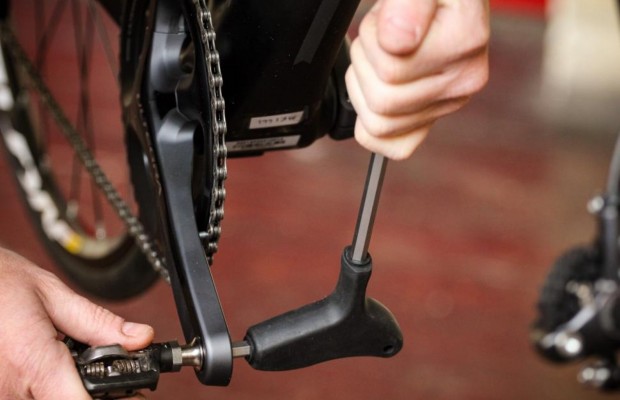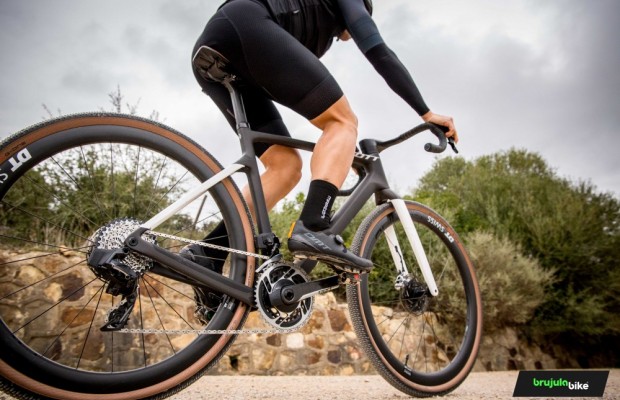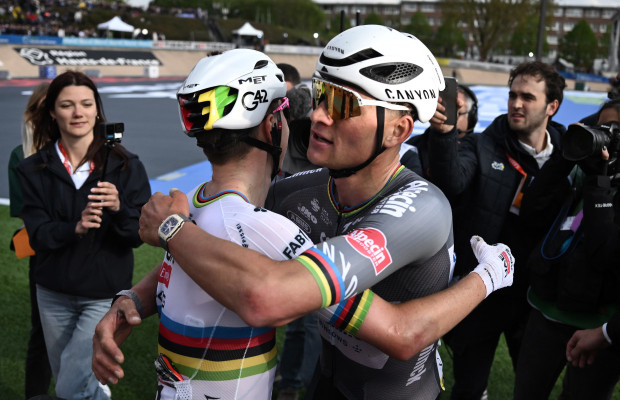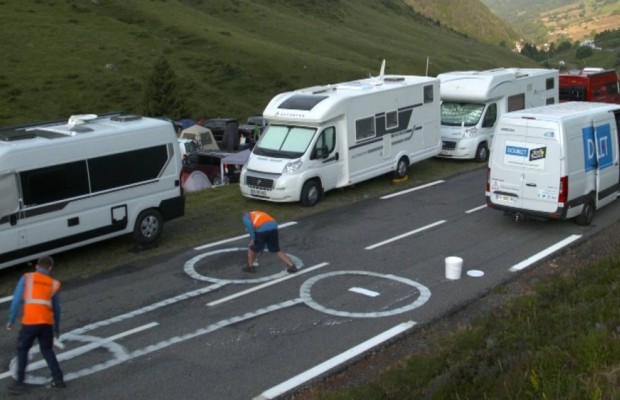SCOTT Foil RC 2023, the renewed Scott missile
We traveled to Lago d'Iseo to get a first-hand look at the new Scott Foil RC 2023, the same one that Team DSM riders will use for the first time in the Tour de France.

Scott evolves its Foil RC to make it even more aerodynamic
Let's go back to 2010. At that time, most bikes still had a traditional look, often simply transferring to carbon fiber what had been done on metal frames forever. Gradually, some brands introduced more elaborate shapes, but often with aesthetics as the sole purpose.
Only Cervélo and a few other brands approached the concept of aerodynamics as a means to improve the cyclist's performance. A word that gradually became more and more popular. However, the implementation of aerodynamic profiles in the tubes had certain limitations: it made the frames less comfortable because they had more material in the longitudinal plane and it was detrimental to stiffness because the cross-section was narrower.

RECOMENDADO

How to wash your cycling clothes? 10 keys to make them always look new

The real importance of signing up for a race

How to change the pedals of any bike in 5 steps

The best gravel groupsets of the moment

Complete list of the highest paid cyclists of 2025

This is how they erase the penises that are drawn on the roads of the Tour de France
It was Scott, with his first Foil, who found the key to solving the problem. Using aerodynamic profiles in which the tail was truncated, so that the air continued to make a similar path but the tubes were more compact lengthwise and could be widened to avoid lateral flex. They called it F01 technology and quickly the other brands began to take aerodynamics into account in their models and to apply a similar solution.
Today, 12 years later, the Scott Foil reaches its 4th generation, seeking not only to further improve aerodynamics thanks to the relaxation of the UCI rules in this regard, but to do so without affecting the weight, stiffness and comfort of a bike that was born with speed and performance as its goal.
Total renovation
If the previous Scott Foil RC model saw the introduction of disc brakes and a clear commitment to aerodynamics as opposed to the more versatile approach of its predecessors, this new Foil RC goes even further in reducing wind resistance by taking advantage of the relaxation of the UCI rules that affected the proportions that the aerodynamic tubes of the bikes had to comply with.
In the process, Scott has taken the opportunity to lighten the Foil RC and give it better power transfer in response to requests from Team DSM's most powerful riders who, despite having the previous version of this bike at their disposal, had hardly used it in favor of the Addict RC, Scott's most climbing option.

3 years of development
It has been three years since the gestation of this Foil RC began. A process that Scott initiated with the design of the aerodynamic qualities of the bike. For this process, the brand has had the collaboration of the aerodynamics guru Simon Smart through his Drag2Zero laboratory, which in the past has already produced good results with bikes as fast as the Scott Plasma time trial.
A process in which different solutions have been designed and simulated through CFD or fluid dynamics software, which were then tested in Drag2Zero's wind tunnel by means of rapid prototypes made with 3D printing.

Among the solutions tested and adopted, Simon Smart himself told us part of this trial and error process to find the best alternative. For example, he explained how the diagonal tube with a clean trailing edge was more efficient than widening it to reduce the influence of the bottles, since the interaction with the legs had a worse final result when a rider was on top of it, or the gain they found in an apparently insignificant point such as the junction between the diagonal tube and the seat tube.

Finally, the main aerodynamic solutions adopted on this Scott Foil RC are in the profile of the deeper down tube, as well as that of the seat tube, which is more vertical and wider, optimized to interact with a 28 mm clincher on the rear wheel.

The steerer tube also grows in the direction of the bike and the fork, which features asymmetrically profiled legs with more curve on the inner face is topped with a flatter, more profiled base that guides air more cleanly into the down tube.

The stays have also been significantly reworked, rotating their profile inwards so that the air flow converges on the turbulence generated by the spokes of the rear wheel, a design that, as they were able to observe in their measurements.
Building a bicycle
After obtaining the desired aerodynamics, the next phase of the process was to create the bike itself. This was the job of the designers, who were responsible for harmoniously joining the different aerodynamic profiles, and of the materials engineers who had to decide, through hundreds of iterations in the finite element analysis software or FEA, how the frame lamination and the different carbon parts were to be used to achieve the desired stiffness and weight parameters.

At this point, Scott has achieved in this Foil RC a bike that is simply rocking but at the same time 9% lighter than the previous generation thanks to the reduction of the parts that make up the frame, just 5 blocks formed by the two rear triangles, the complete front triangle in a single block and a piece that houses the seatpost and the closing wedge that is made separately to have a greater control of the necessary tolerances in such a critical element.

This means that the size 56 Foil RC frame weighs just 915 g, in its top-of-the-range HMX-SL version, including paint and screws. As with the Addict RC, this model will only accompany the most exquisite set-up, while the rest of the collection will have to make do with the HMX frame, which is a few grams heavier.
What about comfort?
We have talked about aerodynamics, stiffness and weight. However, a frame must also have a certain level of absorption so that it does not become unbearable over the hours or when riding on bad roads.
However, Scott has prioritized solidity in the construction of the frame of this Foil RC, leaving the task of absorption in the hands of the 28 mm tires mounted as standard on the rear wheel, while the front is chosen 25 for aerodynamic reasons, although, if we are looking for maximum comfort, it accepts up to 30 mm on both wheels.

But, tires are not enough when it comes to filtering out all the impacts that hit the back of the bike. To add more absorption, Scott has created the Syncros Duncan SL Aero CFT seatpost for this bike. A seatpost divided into two completely independent halves. The front, which is the one that performs structural functions, has a minimal section so it has a large bending range. It rests on the rear part with a deeper profile that performs an aerodynamic function and supports the front half. Both parts are completely independent, only interlocked by a small projection to ensure the correct position.
With bumps, both halves rub against each other so they must be lubricated with a specific silicone-based grease that is water resistant, so we have to check the lubrication about every 1,000 kilometers.

In addition, a second flex zone is added at the top by leaving a gap between where the rear piece ends and the head of the seatpost. A gap that the brand has taken advantage of to place the Syncros Campbell 20 Aero iL rear light that adds extra visibility without breaking the aerodynamics of the bike.
In any case, Scott will have a conventional seatpost with the specific profile of this Foil RC that can be purchased as an option and that will be used on Team DSM bikes to save a few grams at the expense of the comfort it provides.

While we're on the subject of Syncros components, we should also mention the redesign of its integrated Creston iC SL Aero handlebar and stem assembly, which improves aerodynamics with a flatter front area instead of the pronounced Y that describes the one used on the Addict RC.
SCOTT Foil 2023: models, availability and prices
To dress up this Foil RC, Scott has prepared 5 different mounts ranging from SRAM Red to the new Shimano 105 Di2.
Scott Foil RC Ultimate
The top model is the Ultimate model, the same one we were able to ride during the presentation, which is equipped with SRAM Red eTAP AXS and the fabulous Zipp 454 NSW wheels. The only one with the top of the range HMX-SL frame. A bike that is topped off with the Syncros Creston iC SL Aero integrated handlebar stem set. A bike that will leave the scales at 7.22 kg in size 56.

- Frame/Fork: Foil RC HMX-SL
- Groupset: SRAM Red eTAP AXS. Crankset with power meter. Chainring 48/35, 10-33 cassette.
- Handlebars/Stem: Syncros Creston iC SL Aero
- Wheels: Zipp 454 NSW
- Seat post: Syncros Duncan SL Aero CFT
- Saddle: Syncros Belcarra V-Concept 1.0
- Tires: Schwalbe Pro One Microskin TL-Easy. 25 front, 28 rear
Scott Foil RC Pro
Immediately below, the Foil RC Pro version chooses the new Shimano Dura-Ace Di2, which is accompanied by Shimano C50 wheels and the integrated handlebar and stem set. Although it has to make do with the HMX frame, it has a competitive weight of 7.32 kg.

- Frame/Fork: Foil RC HMX
- Groupset: Shimano Dura-Ace Di2. 52/36 chainring, 11-30 cassette.
- Handlebar/Stem: Syncros Creston iC SL Aero
- Wheels: Shimano WH-R9270 C50
- Seat post: Syncros Duncan SL Aero CFT
- Saddle: Syncros Belcarra V-Concept 1.0
- Tires: Vittoria Corsa. 26 front, 28 rear
Scott Foil RC 10
On the third step we have the Foil RC 10, which chooses Shimano Ultegra Di2 for its set-up. The wheels are in charge of the aerodynamic carbon model of the house, a Syncros Capital 1.0 50 of 50 mm profile. From this model onwards, the integrated cockpit is dispensed with and a separate stem and handlebar are chosen. In this case, a Syncros RR 1.5 Aero stem and a Syncros Creston 1.0 Aero handlebar that retains the same aerodynamic design as the integrated set mounted on its bigger siblings.

- Frame/Fork: Foil RC HMX
- Groupset: Shimano Ultegra Di2. 52/36 chainrings, 11-30 cassette.
- Handlebar/Stem: Syncros Creston 1.0 Aero / Syncros RR 1.5 Aero
- Wheels: Syncros Capital 1.0 50
- Seat post: Syncros Duncan SL Aero CFT
- Saddle: Syncros Belcarra V-Concept 2.0
- Tires: Schwalbe One Race-Guard. 25 front, 28 rear
Scott Foil RC 20
Moving into the mid-range, Scott brings us in this Foil RC 20 an assembly based on SRAM Rival eTAP AXS that, like the top model, chooses Syncros Capital 1.0 50 carbon wheels to maintain full performance in the wind. The same Syncros RR 1.5 Aero stem is also found on the frame. However, the handlebars are now the Syncros Creston 2.0 Aero, made of aluminum instead of carbon.

- Frame/Fork: Foil RC 2023 HMX
- Groupset: SRAM Rival eTAP AXS. 48/35 chainring, 10-33 cassette.
- Handlebars/Stem: Syncros Creston 2.0 Aero / Syncros RR 1.5 Aero
- Wheels: Syncros Capital 1.0 50
- Seat post: Syncros Duncan SL Aero CFT
- Saddle: Syncros Belcarra V-Concept 2.0
- Tires: Schwalbe One Race-Guard. 25 front, 28 rear
However, for the moment, only Team DSM riders will be able to enjoy this new machine, since this new Scott Foil RC will not reach the market until the end of 2022. The brand has not wanted to make public the prices of the different set-ups, we assume that we will not know them until units are available.